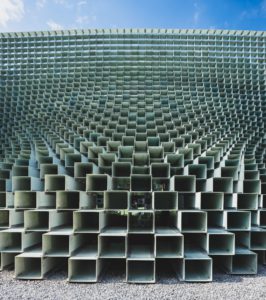Woodform Architectural has prepared a checklist for designers and installers using aluminium battens on the exterior of buildings. Aluminium ceiling joists are available in a variety of shapes and sizes, which allows a designer to create a larger architectural statement with a minimum of building labour. Flat-sheet aluminium siding and panelling have an industrial appeal and work smoothly as an internal or external covering.
Some of the more common finishes on aluminium flat sheet panels include smooth texturing, wood-look, joists, and sash. Aluminium batten is very versatile, it can be made to appear smooth, metallic, or a bit more timber-like–which brings us to the last style of aluminium cladding options. Architectural Aluminium Battens can be used in many applications, from building wooden framed garage doors, to installing batten cladding on walls.
Aluminium Battens can be used for creating wall and ceiling features, both indoor and outdoor applications. The aluminium Click-on Batten System can be used as wall, ceiling, or facade covering, for both interior and exterior applications. Aluminium Click-on Battens are growing in popularity within the world of interior design, both as ceilings and internal feature walls, because their usable lengths (up to 6m), fire-proofing (non-combustible), and durability, all greatly outstrip conventional wood.
Aluminium sheeting is also 100% recyclable, making it an incredibly sustainable material with infinite applications throughout the building industry. Unlike wood, aluminium is virtually an endless resource, a 100% recyclable material that maintains its properties. One of the biggest advantages of using powder-coated aluminium is its low-maintenance nature.
If you live in an area that is susceptible to bushfires, or your project requires using combustible products, then powder-coated, solid aluminium cladding is your best option. Timber alternatives, like wood-look aluminium battens, might suit you if you are looking for a low-maintenance, durable product that will survive Australia’s various conditions.
Depending on what you are going for, using wooden battens can ruin the aesthetics of your project or house. Attaching wood battens to the exterior of a house typically leaves screws and fasteners visible, disrupting a smooth design. To help you choose the right battens for your project, we have identified key differences between genuine wood battens and wood-look, powder-coated aluminium products.

CVS Timber-look, naturally-looking aluminium battens, covered by innovative, easily-installed concealed fasteners, offer a fire-resistant solution in an array of profiles and colours. Duraclad Flux Aluminium Complementary aluminium cladding battens and trims offer a robust, lightweight solution, which is completely fire-rated, providing ultimate peace of mind.
The aluminium Dura Cladding boards are made of a premium, completely recyclable material, providing strong, durable performance yet a lightweight profile that is easier to handle. Due to the lightweight nature of the aluminium cladding, it is possible to add them to older buildings’ exterior walls, without any structural changes or reinforcement. Previously commonly used cladding materials, including composite wood, aluminium composite panels (ACP), all hardwoods (even BAL-compliant hardwoods), and softwoods like Western red cedar, are now prohibited from being used on these buildings’ external walls.
The requirements created an increased demand in Australia for combustible non-cladding materials on the external walls that are either finished with wood, or that look like wood.
For those that like the appearance of timber, but do not want to maintain wood so it keeps looking good year after year, timber-look aluminium is a lightweight alternative compared with composite cladding. Aluminium can also be used for structural reinforcement, or as an alternative to replacing external cladding systems that are made from concrete and wood, which can enhance the appearance of a building. Aluminium sheeting and cladding can be used either with or without removing wood using varying methods of installation.
This method is environmentally useful, in that short pieces of timber are used to produce a final product that is larger, more stable, and easier to fit, and is frequently combined with products such as Glulam and CLT, resulting in a large wooden structural component pay scraper (see below).
References to cladding herein, while most preferentially to the enclosure of a building, do not preclude the interior covering of the framed structure, that is, timber joists may be used behind internal framing on the structure of a building (whether externally covered with cladding or not, such as plasterboard). The proposed cladding has the capacity of distancing cladding from the framed structure (whether wood, metal or otherwise, whether in contact therewith either directly or indirectly, for example, by means of a sheet or other layup materials). The aforementioned Patent Specification, with regard to a residential or commercial housing enclosure clad in wood (and especially, but not exclusively, walls), proposed that battens are used in order to provide that clad cavity are not constrictive of draining and/or ventilating liquid flows.
In use, preferably, a number of battens, as shown in Figure 1, may be attached against building paper at the exterior of the framing (e.g., a steel or wooden framing member) and subsequently be fastened by nails or other means.
The decorative aluminium cladding range offers a genuine wood finish, providing a realistic wood grain appearance on cladding and timber panels, as well as a unique metallic finish, while still gaining the benefits of aluminium. From Wood-to-Metal Looks, Natural Touch: Photo-realistic aluminium cladding profiles meet any desire, and fit any kind of home, and any exterior colour. Aluminium exteriors also significantly enhance insulation, which helps to minimise energy-wasting methods for controlling the temperature inside your house, like heaters or air conditioning.
Acoustical support panels can be integrated into a system, providing an effective acoustic solution, but also replacing the need for applying plasterboard and painting the walls, or painting behind the aluminium ceiling tiles, saving both time and money.
